This sea freight forwarding guide is your guiding light on how international ocean shipping works. From booking containers to customs clearance, it covers types like FCL and LCL, walks you through the sea freight forwarding process step by step, and explains what affects pricing.
- What is Sea Freight Forwarding?
- How It Works
- Why It Matters for Global Shipping
- Types of Sea Freight Shipping
- Full Container Load (FCL)
- When to Use It & Its Benefits
- Less than Container Load (LCL)
- When LCL Makes Sense for Your Cargo
- FCL vs LCL: What Should You Choose?
- Step-by-Step Sea Freight Forwarding Process
- Cargo Booking & Documentation
- Export Haulage and Port Handling
- Customs Clearance and Ocean Transit
- Destination Port Arrival and Delivery
- What Affects Sea Freight Rates?
- Volume, Weight, and Container Type
- Port Charges, Route, and Surcharges
- Seasonal Demand and Shipping Conditions
- Benefits of Using Sea Freight Forwarding
- Handles Large or Heavy Cargo Easily
- Cost-Effective for Long Distances
- Fewer Restrictions on Dangerous Goods
- Sustainable and Eco-Friendly Option
- Challenges to Be Aware Of
- Longer Transit Times
- Risk of Delays or Port Congestion
- Limited Tracking vs Sea Freight
- Documentation Errors and Customs Delays
- Sea Freight Forwarders: What They Do and Why You Need One
- Their Role in Managing Shipments
- How They Help with Customs and Compliance
- Value-Added Services You Should Ask For
- Choosing the Right Sea Freight Forwarder
- Checklist for Selecting a Good Forwarding Partner
- Red Flags to Watch Out For
- Questions to Ask Before Signing a Contract
- Case Study or Real Example
- The Challenge
- The Solution Provided
- The Outcome
- FAQs on Sea Freight Forwarding
- What documents are required for sea freight?
- How long does ocean shipping take from UAE to Russia?
- Can I ship personal items via sea freight?
- Final Thoughts: When Should You Use Sea Freight?
- Quick Recap on the Pros and Use Cases
- Best Scenarios Where Sea Freight Makes Sense
- Need help figuring out your next shipment?
It also focuses on the benefits and challenges of shipping by sea, along with tips on picking the right freight forwarder. If you’re wondering how the sea freight forwarding process works in Dubai, this guide simplifies sea freight for businesses of all sizes.
What is Sea Freight Forwarding?
Companies rely on ocean shipping to transport massive cargo across the globe via freight ship. Instead of using air or road transport, they load goods into ships’ holds in large containers and then transport them by sea.
Let me put it in a very simple way: Suppose you have to send a very large number of parcels from Dubai to Europe. You know, air freight would be too expensive. So, you basically pack everything into one container, and a shipping agent takes care of all the logistics.
That means, along with getting a spot on the ship, they also handle customs, provide vehicles at the port, and make sure your goods are delivered safely.
A guide to sea freight forwarding explains this process for newcomers to global trade.
Whether you’re moving one container or just part of one (like in LCL shipping), freight forwarding makes the process smoother and way less stressful.
How It Works
Think of sea freight forwarding like hiring someone to organize your cargo’s long ocean journey. A freight forwarder doesn’t own the ships but knows exactly how to move your stuff from A to B. From booking containers to handling paperwork, they’ve got it covered.
Why It Matters for Global Shipping
Ocean shipping is the major way of transporting goods across international borders. Whether it’s furniture, machines, or clothing, these items made their journey on a ship. A solid guide to basics of ocean freight helps businesses avoid delays, save money, and ship smarter.
Types of Sea Freight Shipping
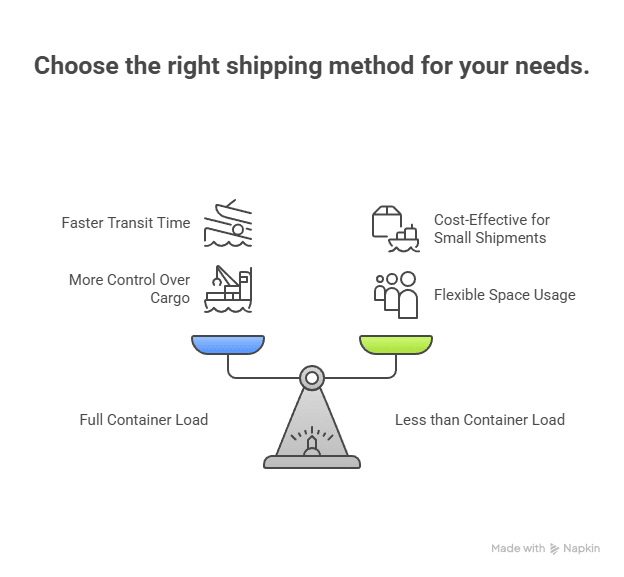
Full Container Load (FCL)
You rent the whole container, even if you don’t fill it completely. Good for large shipments.
When to Use It & Its Benefits
FCL is ideal when you want faster transit, more control, or have enough cargo to fill most of a container.
Less than Container Load (LCL)
You share the container space with other shipments. It’s budget-friendly if your load is small.
When LCL Makes Sense for Your Cargo
If you’re sending a few boxes or pallets, LCL works great. You pay only for the space you use.
FCL vs LCL: What Should You Choose?
FCL is faster and more secure. LCL is cheaper for smaller shipments. It all depends on what you’re shipping and how urgent it is.
Step-by-Step Sea Freight Forwarding Process
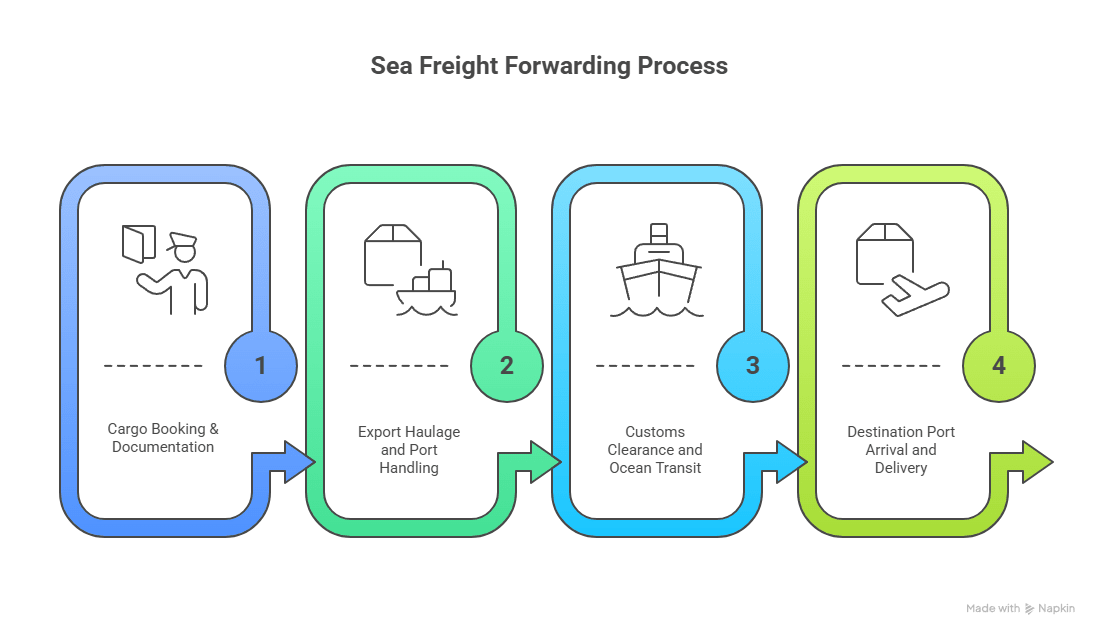
This sea freight forwarding process step by step will make the whole thing feel less overwhelming:
Cargo Booking & Documentation
You send shipment details. The forwarder books space and preps documents like the bill of lading and commercial invoice.
Export Haulage and Port Handling
The cargo is moved from your warehouse to the port. There, it gets loaded into a container.
Customs Clearance and Ocean Transit
Your shipment cleared customs, then sailed to the destination port. This is where delays sometimes happen.
Destination Port Arrival and Delivery
Once it lands, another round of customs, then off it goes to your final location.
If you’re wondering how the sea freight forwarding process works in Dubai, it’s almost the same—except Dubai’s ports are super organized and digital-friendly.
What Affects Sea Freight Rates?
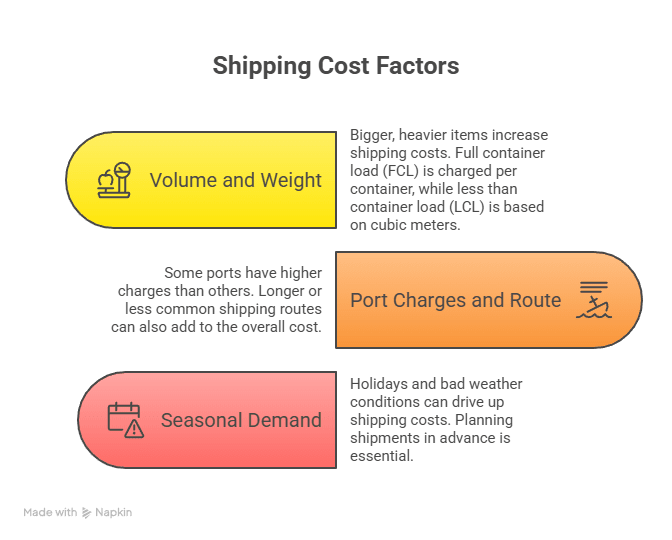
Volume, Weight, and Container Type
Bigger, heavier stuff costs more. Also, FCL is charged per container, while LCL is based on cubic meters.
Port Charges, Route, and Surcharges
Some ports charge more than others. Longer or less common shipping routes might add fees.
Seasonal Demand and Shipping Conditions
Holidays and bad weather raise costs. Planning ahead is key.
Benefits of Using Sea Freight Forwarding
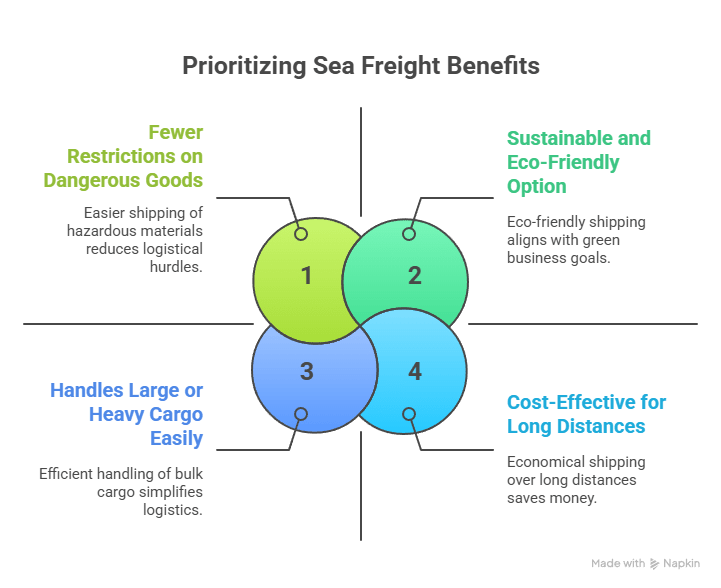
This guide simplifies sea freight for businesses, but here’s why it’s worth it:
Handles Large or Heavy Cargo Easily
Shipping a car or 10 tons of tiles? No problem. Ships are built for bulk.
Cost-Effective for Long Distances
It’s cheaper than air freight—especially for big loads going far.
Fewer Restrictions on Dangerous Goods
Some items (like certain chemicals) ship more easily by sea.
Sustainable and Eco-Friendly Option
Compared to planes, ships emit less CO2 per ton. Great for green goals.
Challenges to Be Aware Of
Longer Transit Times
Sea freight forwarding is great for big shipments, but it’s not the fastest option out there. Unlike air cargo that takes a couple of days, ocean freight forwarding can take several weeks depending on the route and destination.
For example, shipping from Dubai to Russia might take 25–35 days. That’s why businesses using the sea freight forwarding process need to plan early—especially during peak seasons when port traffic increases. If your cargo isn’t time-sensitive, sea shipping is still an affordable solution.
Risk of Delays or Port Congestion
A smooth sea freight forwarding process step by step can hit bumps, especially at major ports. Congestion, strikes, or customs slowdowns can all delay your shipment. Ports in busy global hubs like Dubai often encounter high container traffic, which sometimes causes bottlenecks.
To minimize issues, your freight forwarder should stay updated on port schedules, shipping line performance, and alternative routes. Choosing someone experienced in how the sea freight forwarding process works in Dubai can save you days of delay.
Limited Tracking vs Sea Freight
When using ocean freight forwarding, you won’t get detailed tracking like you do with courier services or air cargo. Sea shipments move slowly, and tracking updates are usually tied to port stops, not every few hours.
However, most good sea freight forwarders now offer digital systems that let you track container status by vessel name, estimated arrival time, and real-time location data. If real-time visibility is critical for your business, make sure to ask what tracking options they provide during the freight forwarding process.
Documentation Errors and Customs Delays
If your paperwork isn’t 100% accurate, your container might sit at the port for days. In the ocean freight forwarding process, key documents like the bill of lading, commercial invoice, and packing list must match customs requirements in both origin and destination countries.
Even one small error—like a typo in the HS code—can trigger extra inspections or rejections. That’s why choosing a reliable sea freight forwarding company that handles documentation professionally is a smart move for avoiding costly delays.
Sea Freight Forwarders: What They Do and Why You Need One
Their Role in Managing Shipments
They organize bookings, paperwork, and logistics. Like travel agents—but for cargo.
How They Help with Customs and Compliance
They know the rules in each country and make sure your shipment doesn’t get stuck.
Value-Added Services You Should Ask For
Cargo insurance, warehousing, multi-country logistics—they can handle a lot more than shipping.
Choosing the Right Sea Freight Forwarder
Finding a suitable sea freight forwarder is definitely more than just matching prices. It is about engaging with a person who is familiar with your cargo, clearly understands and communicates your requirements, and is able to provide the agreed service on time and without any issues.
A reliable freight forwarder is like a logistics partner. Besides, they are very familiar with freight routes both inland and ocean, port regulations, customs paperwork, and container types. Most importantly, they are the people who know how to fix situations if things go wrong.
Checklist for Selecting a Good Forwarding Partner
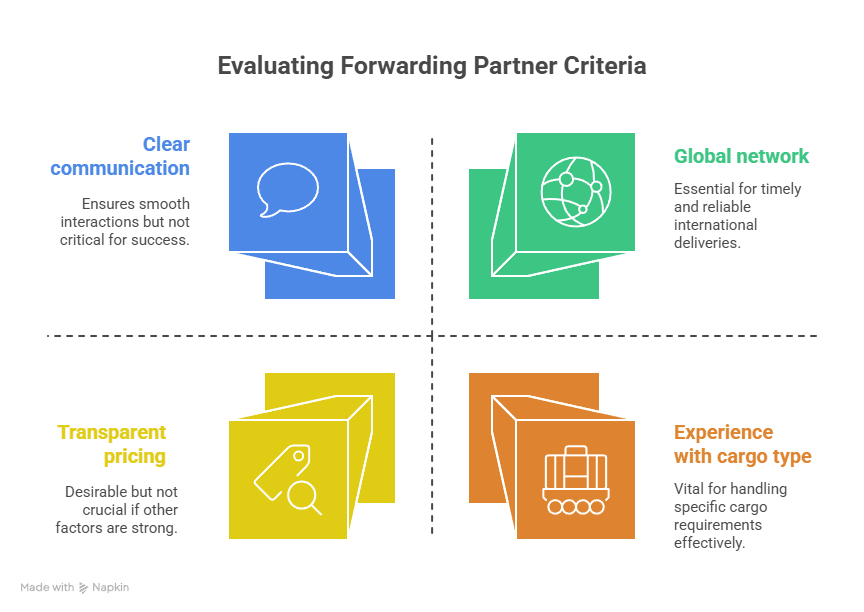
Experience with your cargo type – They should have handled goods like yours before (e.g., fragile items, machinery, electronics).
Clear communication – Look for someone who explains things in plain language and keeps you updated.
Global network – A solid presence in your destination country makes a big difference in delivery speed and reliability.
Transparent pricing – All fees should be explained clearly upfront, with no hidden costs later.
Red Flags to Watch Out For
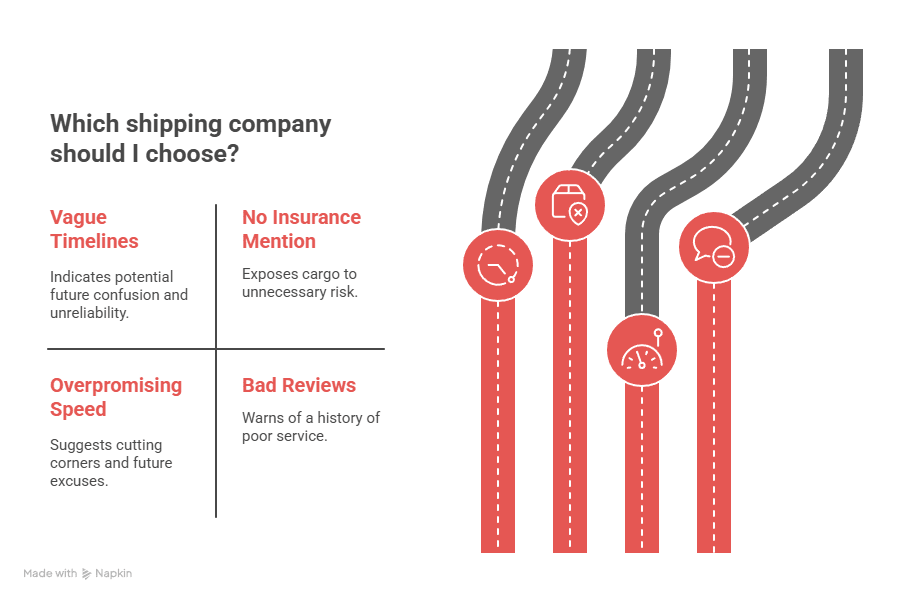
Vague timelines or unclear answers – If they dodge basic questions now, expect confusion later.
No mention of insurance – This puts your cargo at unnecessary risk.
Overpromising on delivery speed – Unrealistic promises usually mean cutting corners or future excuses.
Bad or repetitive reviews – A history of poor service is a clear warning sign.
Questions to Ask Before Signing a Contract
Can I track my shipment in real time? – Know how and when you’ll get updates.
How do you handle customs paperwork? – Make sure they’ll manage it properly to avoid delays.
What happens if something goes wrong? – Ask about their process for delays, damage, or missing cargo.
Case Study or Real Example
The Challenge
A company needed to ship custom furniture from UAE to Germany—fast.
The Solution Provided
A local forwarder handled FCL booking, port loading, and customs clearance in just 2 days.
The Outcome
Shipment arrived ahead of schedule, saving client warehouse costs.
FAQs on Sea Freight Forwarding
What documents are required for sea freight?
At minimum: bill of lading, invoice, packing list, and shipping instructions.
How long does ocean shipping take from UAE to Russia?
Usually 25–35 days, depending on transshipment ports and weather.
Can I ship personal items via sea freight?
Yes, many people use LCL for personal moves. It’s cheaper than air shipping.
Final Thoughts: When Should You Use Sea Freight?
Quick Recap on the Pros and Use Cases
Use sea freight when you’ve got large or heavy items, flexible timelines, or long-distance routes.
Best Scenarios Where Sea Freight Makes Sense
- International business shipments
- Bulk orders
- Household relocations
- Long-term supply chains
If you are still not sure about any of this, then you need to talk to a freight expert. Just one correct piece of advice can be equivalent to days, money and stress reduction.
Need help figuring out your next shipment?
Let Triroute handle the details—from booking to delivery. Whether it’s a full container or just a few pallets, we’ll ensure it arrives smoothly.
Reach out today and ship with confidence.






